Vegetable Kabsa (Saudi Rice Dish)
A flavorful and aromatic Saudi rice dish, loaded with a variety of vegetables and spices, served with a side of daqqous sauce.
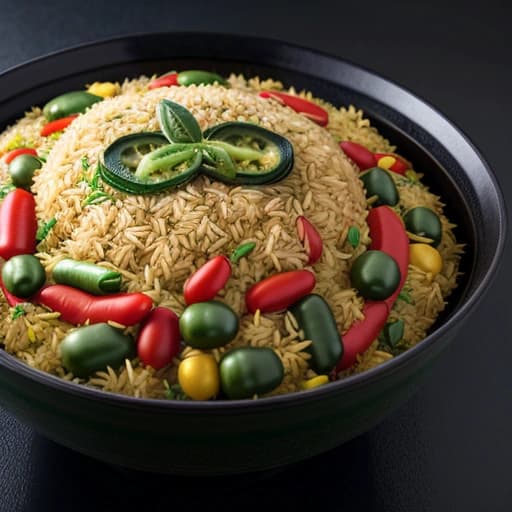
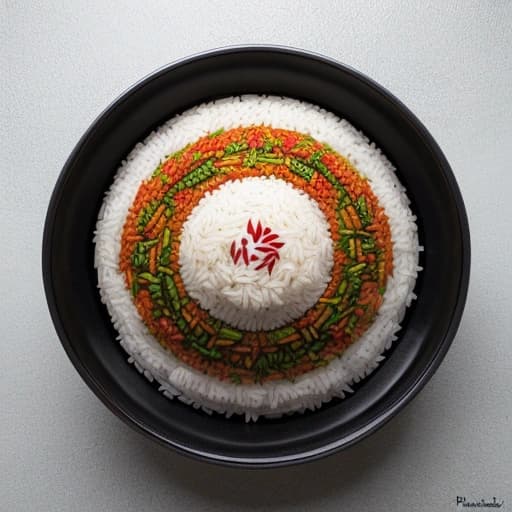
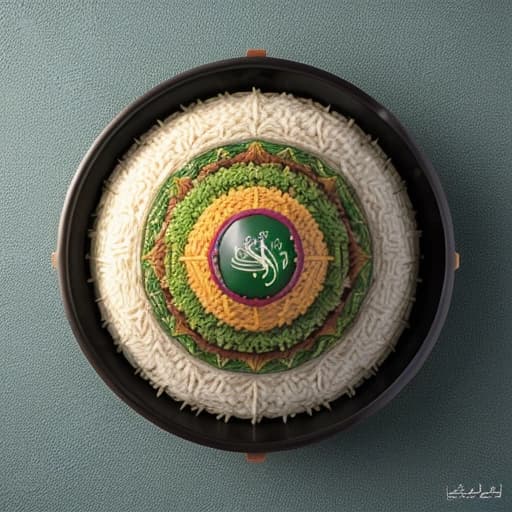
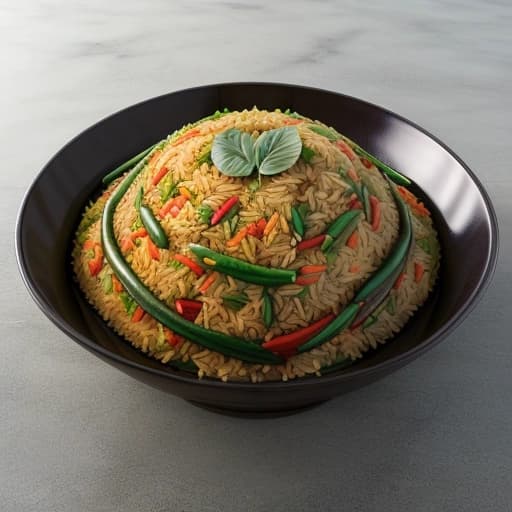
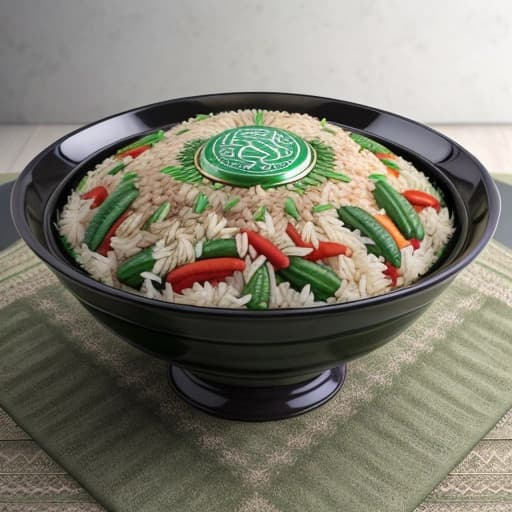
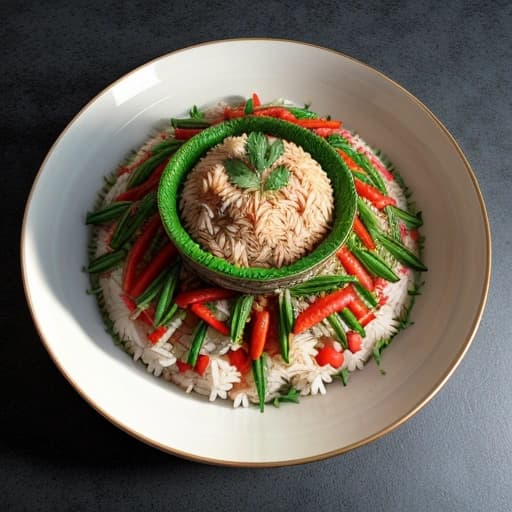
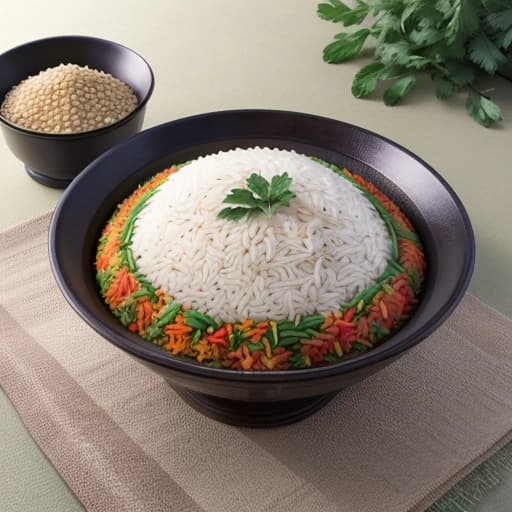
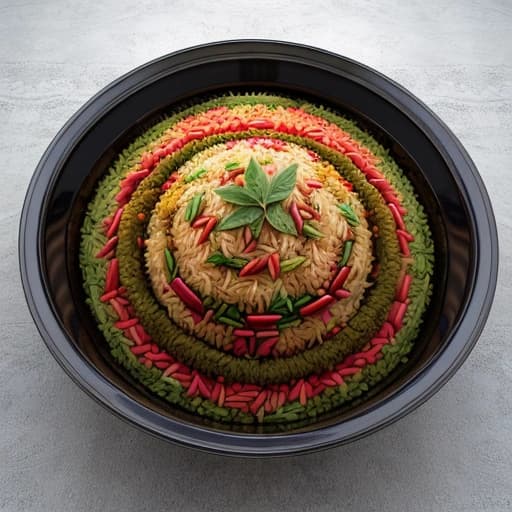
4.5 / 5 (720)
Ingredients
Grains
- Basmati Rice
2 cups
- Vermicelli
1 cup
Protein Sources
- Tofu
1 block
Aromatics
- Onion
2 medium
- Garlic
3 cloves
- Ginger
1 inch
Vegetables
- Carrots
2 medium
- Potatoes
2 medium
- Zucchini
1 medium
- Bell Peppers
2 medium
- Tomatoes
2 cups
Spices
- Cumin
1 teaspoon
- Coriander
1 teaspoon
- Turmeric
1 teaspoon
- Red Chili Powder
1 teaspoon
- Garam Masala
1 teaspoon
- Salt
a pinch
- Black Pepper
a few grinds
Oils
- Vegetable Oil
2 tablespoons
Sauces
- Tomato Paste
2 tablespoons
Instructions
- 1
Heat oil in a large pot over medium heat.
Begin by heating the oil in a large pot over medium heat, this will help in cooking the aromatics.
- 2
Add onion, garlic, and ginger, and cook until the onion is translucent.
Add the sliced onion, minced garlic, and grated ginger to the pot. Cook, stirring occasionally, until the onion is translucent and starting to caramelize.
- 3
Add the spices and cook for 1 minute.
Add the cumin, coriander, turmeric, red chili powder, garam masala, salt, and black pepper to the pot. Cook for 1 minute, stirring constantly, until the spices are fragrant.
- 4
Add the vermicelli and cook, stirring constantly, until it is lightly browned.
Add the vermicelli to the pot and cook, stirring constantly, until it is lightly browned.
- 5
Add the rice and cook for 2 minutes.
Add the basmati rice to the pot and cook for 2 minutes, stirring constantly, until the rice is well coated with the spice mixture.
- 6
Add the vegetables, tomato paste, and 4 cups of water to the pot.
Add the sliced carrots, diced potatoes, sliced zucchini, sliced bell peppers, and chopped tomatoes to the pot. Also, add the tomato paste and 4 cups of water to the pot.
- 7
Bring the mixture to a boil, then reduce the heat to low, cover, and simmer for 20-25 minutes.
Bring the mixture to a boil, then reduce the heat to low, cover the pot with a tight-fitting lid, and simmer for 20-25 minutes, or until the rice is cooked and the vegetables are tender.
- 8
Turn off the heat and let it rest for 5 minutes.
Once the kabsa is cooked, turn off the heat and let it rest, covered, for 5 minutes. This will help the flavors to meld together and the rice to steam.
- 9
Fluff the kabsa with a fork and serve hot.
After the kabsa has rested, fluff it with a fork to separate the grains and serve it hot, garnished with chopped fresh parsley or cilantro, if desired.
Ratings & Reviews
User Ratings
5
469
4
159
3
61
2
29
1
2
Reviews
 Yara_Yasmin
Yara_YasminMan, I'm totally vibing with the flavors here, but it's not exactly my go-to, you know? I mean, I'm all about that seafood life, and this Vegetable Kabsa is straight fire... for veggies, that is! As a pescatarian who loves traditional Brazilian cuisine, I gotta say that this Saudi rice dish is a bit of a departure from my usual açaí bowls and seafood feasts. That being said, the spice game is strong, and I'm loving the aromatic flavors. If I could remix this recipe, I'd def add some fresh seafood to give it that Brazilian twist. Maybe some grilled shrimp or fish to make it pop? Anyway, it's a solid 2 stars from me - it's a tasty dish, but it's not my jam, if you feel me
 Nadou87
Nadou87I found the Vegetable Kabsa recipe to be a delightful and flavorful dish that aligns with my appreciation for Mediterranean cuisine. The combination of aromatic spices, including cumin, coriander, and turmeric, with a variety of vegetables such as carrots, potatoes, and zucchini, creates a truly satisfying meal. I particularly enjoy that the recipe is halal-friendly, which is essential for my dietary preferences. However, I do wish to note that the inclusion of vermicelli, a type of pasta, may pose a challenge for individuals with gluten intolerance, such as myself. Nevertheless, I believe that with a simple substitution, this dish can be easily adapted to accommodate gluten-free dietary needs. Overall, I would highly recommend this recipe to those who appreciate traditional Saudi cuisine and are looking for a hearty, flavorful meal to share with family and friends.
 CassieNW
CassieNWI'm absolutely delighted with this Vegan Vegetable Kabsa recipe! As someone who's passionate about plant-based eats and environmental sustainability, I was thrilled to see a dish that not only aligns with my values but also tantalizes my taste buds. The use of tofu as a protein source is a great touch, and I appreciate the variety of colorful veggies that make this dish a feast for the eyes. I do wish there were a few more creative twists to make it feel more unique, but overall, the flavors and textures come together beautifully. The fact that it's made with sustainable ingredients like basmati rice and an array of spices makes it a winner in my book. One minor suggestion I might make is to consider adding some fresh herbs or edible flowers to give it an extra pop of flavor and color. That being said, I'd definitely make this again and share it with friends and family. The only reason I wouldn't give it a perfect 6/5 stars is that I'm always on the lookout for new and exciting flavor combinations - but this dish definitely hits the spot!
 EthanOD85
EthanOD85I must admit that I approached this Vegetable Kabsa recipe with a certain degree of skepticism, given my penchant for fine dining and a predominantly carnivorous diet. As a connoisseur of French and Italian cuisine, I was not immediately convinced by the prospect of a Saudi rice dish, no matter how flavorful it may be. Upon preparing and sampling the dish, I found it to be satisfactorily aromatic and flavorful, with a pleasing balance of spices. However, I couldn't help but feel that the absence of meat or poultry detracted from the overall dining experience. Furthermore, as someone with a mild gluten intolerance, I was pleased to note that the recipe did not include any gluten-containing ingredients, which was a welcome relief. In conclusion, while this Vegetable Kabsa was not a standout dish in my opinion, it may appeal to those with a more adventurous palate or a vegetarian/vegan dietary preference.
 NaliRavi27
NaliRavi27I tried this Vegetable Kabsa recipe and loved the mix of spices and veggies! As a vegetarian, I appreciated the variety of vegetables used, like carrots, potatoes, and zucchini. The basmati rice was a nice touch, but I had to be careful with the vermicelli to make sure it was gluten-free. The daqqous sauce on the side was a great addition. I enjoyed learning about this Saudi dish and how it's traditionally served. It reminded me of the street food I love back home in India. The only thing I would change is adding some dosa-style fermentation to the rice for an extra kick! Overall, a delicious and aromatic dish that's perfect for sharing with friends and family.
 LuluArg93
LuluArg93This Vegetable Kabsa recipe is a **hidden gem**! As someone who enjoys trying new flavors and dishes, I was excited to give this Saudi rice dish a shot. The combination of spices, including cumin, coriander, and turmeric, was **absolutely delightful**. I loved how the recipe included a variety of vegetables, such as carrots, potatoes, and bell peppers, which added texture and flavor to the dish. The only downside was that I had to make some substitutions due to my lactose intolerance, but the dish still turned out great. I would definitely recommend this recipe to anyone looking to try something new and **delicious**.
 CaspianTheGrey
CaspianTheGreyI must say that I was thoroughly unimpressed with this Vegetable Kabsa recipe. As a connoisseur of fine dining, particularly French cuisine, I found the dish to be lacking in sophistication and refinement. The use of tofu as a protein substitute was a misstep, and the overall flavor profile was far too pedestrian for my taste. The spice blend, while aromatic, was overly reliant on turmeric and cumin, which I found to be a bit too bold and overpowering. The inclusion of vermicelli and basmati rice was a nice touch, but ultimately, the dish felt like a lazy attempt at a traditional Saudi rice dish. I would not recommend this recipe to anyone seeking a truly exceptional dining experience. In fact, I would suggest that those with a discerning palate, such as myself, look elsewhere for a more satisfying culinary experience. One redeeming quality of the recipe was its attention to detail, which I appreciated. However, that was not enough to save it from its overall mediocrity.
 casper_dk1985
casper_dk1985This Vegetable Kabsa recipe was pretty solid, I'd say it's a 4/5 for me. I mean, who doesn't love a good rice dish, right? The spices were on point, and I loved the variety of veggies. However, as a lactose intolerant dude, I was a bit worried about the potential dairy situation, but luckily, it was dairy-free. My only gripe is that it could've used a bit more sweetness to balance out the heat from the red chili powder. Maybe add some dates or a drizzle of honey? That being said, I'd def make it again, and I'd recommend it to anyone looking for a flavorful, veggie-packed meal. Oh, and btw, can someone pls tell me where's the beef?
 Kairos23
Kairos23### Not My Usual Cup of Tea I tried Vegetable Kabsa, a Saudi rice dish. The dish had many vegetables, which I didn't mind, but it was missing meat. I like meat. The recipe said it was medium difficulty, which was okay for me. I cooked it in about 50 minutes. The flavors were interesting, with many spices like cumin and coriander. However, it wasn't very spicy, which was a bit disappointing for me. I like spicy food. I think the dish was good, but not great. I might try it again with some meat added. The instructions were clear, but some words were hard to understand. I'm still learning English, so that was a bit difficult for me. Overall, it was an okay experience. I might try more recipes like this in the future, but with meat, please!
 NaliniJ85
NaliniJ85I must commend the creator of this Vegetable Kabsa recipe for their innovative approach to traditional Saudi cuisine. As a vegetarian who appreciates diverse flavors, I found the combination of spices and vegetables in this dish to be quite intriguing. The addition of cumin, coriander, and turmeric gave the kabsa a warm, aromatic flavor profile reminiscent of Indian and Middle Eastern biryanis. I particularly enjoyed the variety of vegetables used, such as carrots, potatoes, and bell peppers, which added texture and flavor to the dish. However, I would suggest a few modifications to make it more akin to a South Indian or curry-inspired dish. Perhaps adding some coconut milk or yogurt to the tomato paste could enhance the creaminess and richness of the sauce. Additionally, substituting some of the spices with South Indian staples like curry leaves or mustard seeds could further elevate the flavor. Overall, I appreciate the effort that went into creating this recipe, and I look forward to trying it with some tweaks to suit my taste preferences.